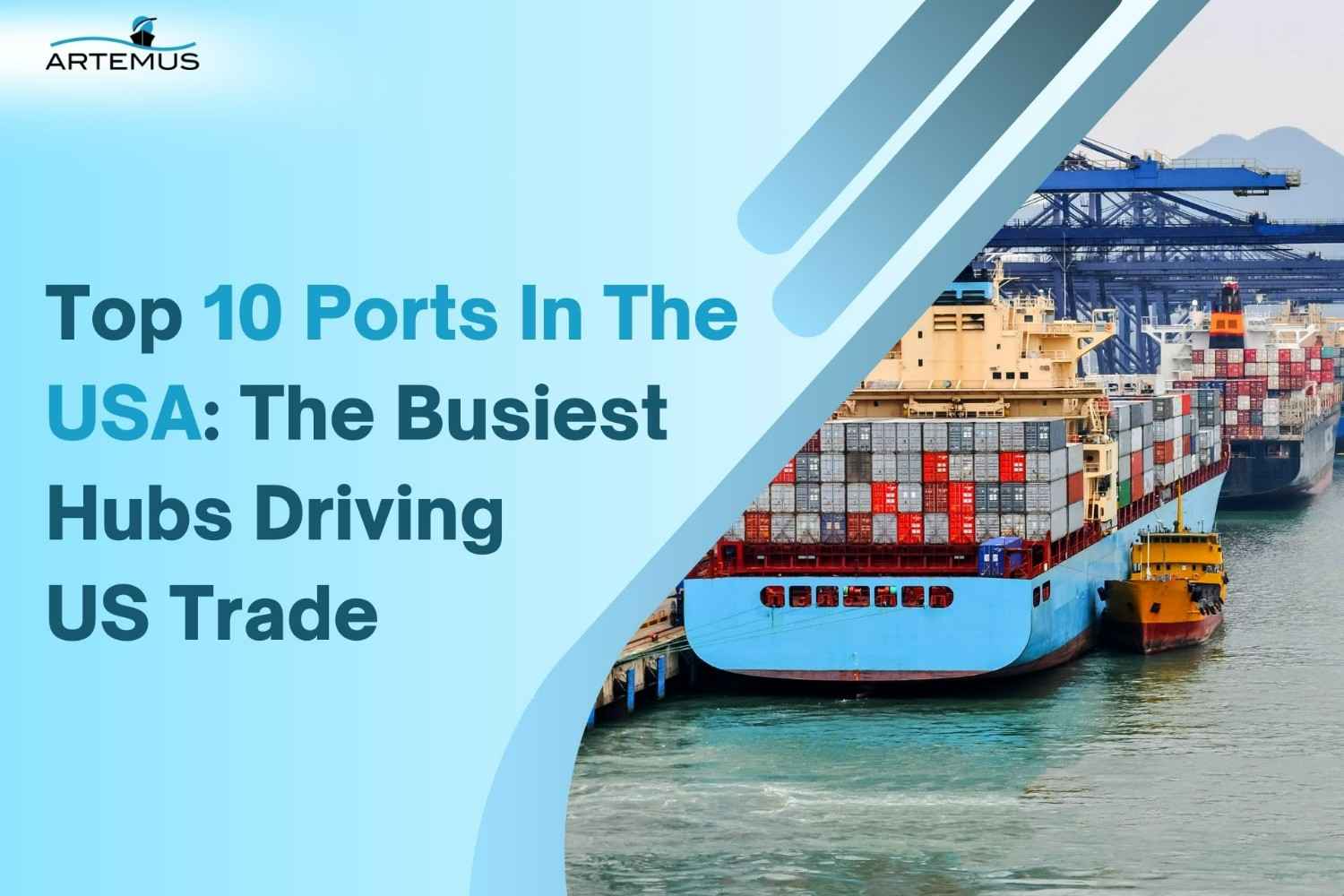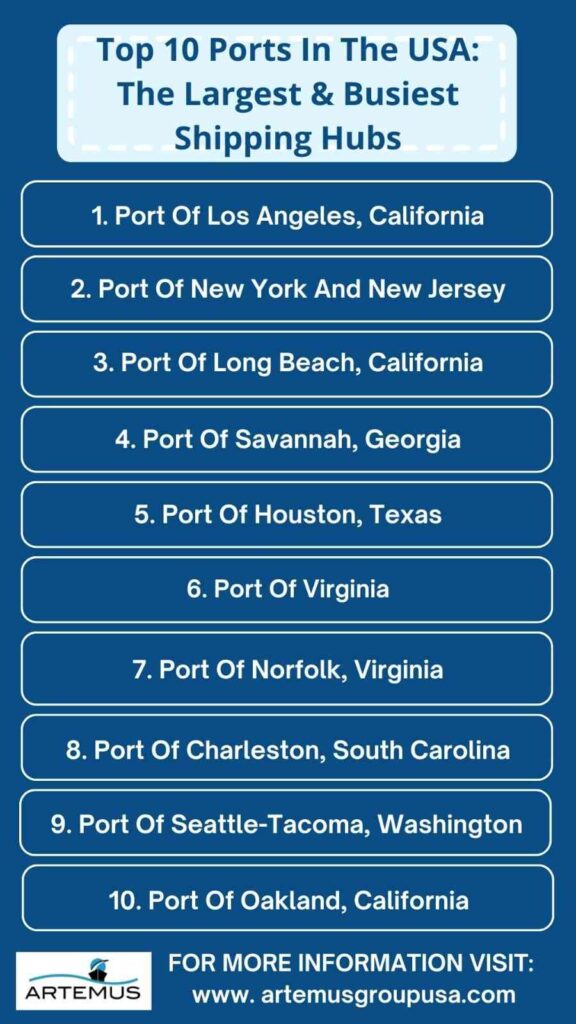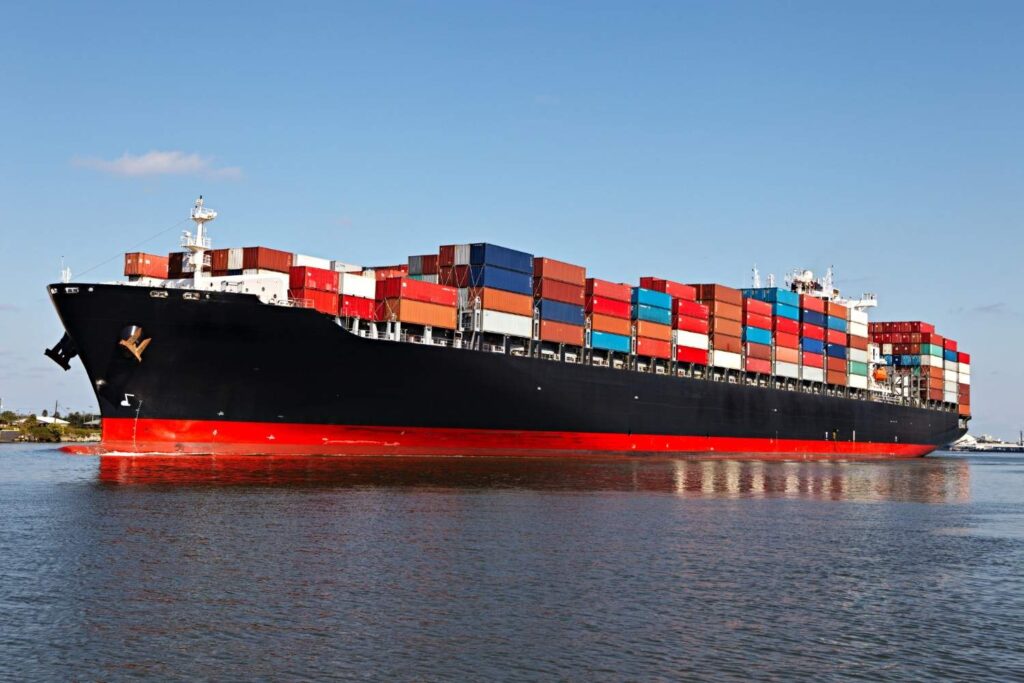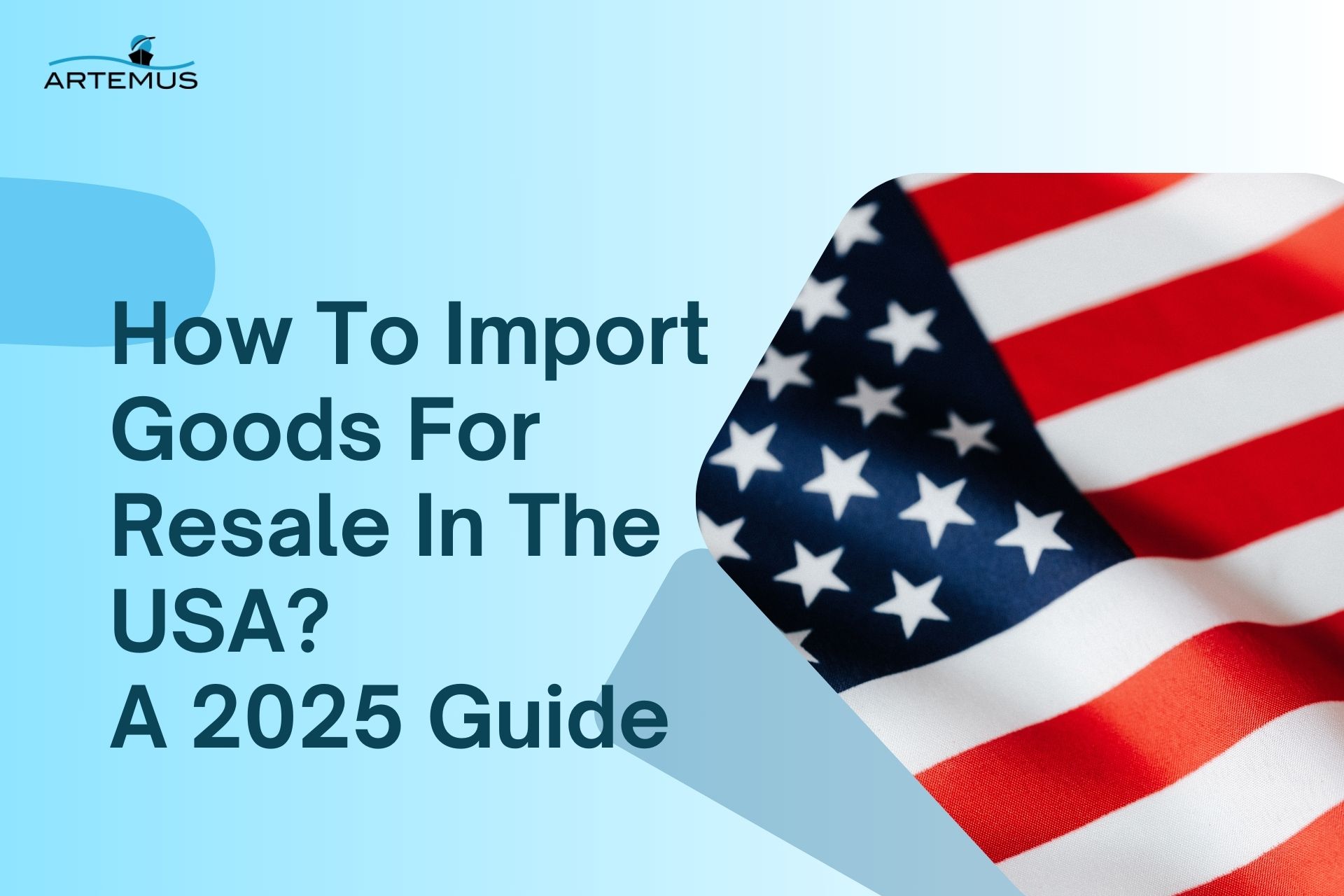
What Is Inbound Logistics & Outbound Logistics? A 2025 Guide
In the dynamic world of supply chain management, understanding the nuances of inbound and outbound logistics is crucial for operational

When it comes to international trade, the United States is home to some of the busiest and most important ports in the world. These ports serve as critical gateways for goods flowing in and out of the country, supporting global supply chains and contributing significantly to the U.S. economy.
From the bustling West Coast to the strategic East Coast, each port has its unique capabilities and strengths. In this blog, we’ll explore the top 10 ports in the USA, highlighting their importance in shipping and logistics.
Additionally, Artemus Transportation Solutions plays a vital role in ensuring seamless compliance for imports and exports, offering advanced solutions for ISF, AMS, and AES filings that help streamline the shipping process and maintain regulatory standards.
Table Of Contents

The United States boasts a vast network of ports that are pivotal to its economy, facilitating the movement of goods both domestically and internationally. These ports vary in size, cargo volume, and specialization. Below is an overview of the top 10 largest and busiest ports in the U.S., along with key metrics highlighting their significance.
The Port of Los Angeles, often referred to as “America’s Port,” is the busiest and largest container port in the United States. Located in Southern California, it handles a vast volume of international trade, primarily from Asia.
With its strategic location, cutting-edge facilities, and strong connections to rail and trucking systems, the port plays a critical role in the U.S. economy and global supply chains. Its extensive infrastructure, including 43 miles of waterfront and 12 terminals, ensures efficient operations and accommodates millions of containers annually.
The Port of New York and New Jersey is the largest port on the East Coast of the United States, serving as a key gateway for international trade between the U.S. and Europe, Asia, and Latin America.
Positioned at the mouth of the Hudson River, it is a vital hub for cargo traffic, moving goods across the U.S. via road, rail, and inland waterways. With a deepwater harbor, advanced logistics infrastructure, and strategic location, the port handles millions of tons of cargo and plays a central role in the region’s economy.
Located next to the Port of Los Angeles, the Port of Long Beach is one of the busiest ports in the United States and a major global gateway for trade, particularly from Asia. Known for its deep-water capabilities and modern infrastructure, Long Beach handles a wide range of goods, including containers, automobiles, and bulk cargo.
As a key player in the Southern California trade corridor, the port is integral to the U.S. economy, facilitating efficient cargo operations and bolstering international supply chains.
The Port of Savannah is one of the fastest-growing ports in the United States, particularly known for its exceptional efficiency in container handling. Situated on the Atlantic coast, Savannah’s deepwater terminals, including the expansive Garden City Terminal, allow it to handle large volumes of imports and exports.
The port’s excellent rail connectivity and proximity to major highways ensure that it remains a crucial link in both U.S. and international trade, contributing significantly to Georgia’s economy and creating thousands of jobs.
The Port of Houston is a vital hub for the Gulf Coast, known for its extensive petroleum and petrochemical cargo handling. It is the largest port in the United States in terms of total tonnage, processing a diverse array of goods, including oil, chemicals, and containers.
The port’s location along the Houston Ship Channel makes it a prime trade center, and its advanced infrastructure supports heavy industrial sectors while maintaining strong trade ties with international markets, particularly in the energy sector.
The Port of Virginia is a leading East Coast port that serves as a key player in the U.S. trade network. Known for its deep-water capabilities and modern terminal facilities, it handles a broad range of cargo, including containers, bulk goods, and automobiles.
The port’s efficient operations, supported by a vast rail network, make it an attractive choice for businesses looking to move goods quickly and reliably along the eastern seaboard. Its continued growth and expansion underscore its importance in global trade..
Part of the Port of Virginia, the Port of Norfolk is a critical node in the U.S. East Coast shipping network. It plays a significant role in moving containerized cargo and bulk goods, with a focus on efficient handling and quick turnaround times.
Norfolk’s proximity to major shipping lanes and robust infrastructure, including a vast network of highways and railroads, allows it to support industries across the United States, making it one of the busiest ports in the region.
The Port of Charleston is a leading container port on the East Coast of the United States, known for its rapid growth and strong logistics capabilities. With its strategic location along the Atlantic coast and its efficient terminals, the port has become a major gateway for global trade, particularly with Europe and Asia.
Charleston’s deep-water harbor allows it to handle large vessels, and its advanced infrastructure supports the movement of diverse goods across the region and beyond.
The Port of Seattle-Tacoma, collectively known as the Northwest Seaport Alliance, is a crucial gateway for trade between the United States and Asia. The port handles a wide variety of cargo, with a primary focus on containerized goods.
Its state-of-the-art facilities and strategic location along the Pacific Coast make it a vital trade hub for the region, supporting the movement of goods across the U.S. and fostering strong international trade relationships, particularly with Pacific Rim countries.
The Port of Oakland is a major hub for trade along the U.S. West Coast, particularly known for its containerized cargo operations. Located in the San Francisco Bay Area, it serves as a critical gateway for imports and exports, with a strong emphasis on trade with Asia.
The port’s advanced infrastructure, including automated systems and efficient terminal operations, makes it a leader in container throughput, supporting not only regional but also national supply chains. Its importance in the Bay Area economy and beyond is substantial.
These ports are integral to the U.S. economy, facilitating the import and export of goods, creating employment opportunities, and supporting various industries. Their strategic locations and infrastructure investments.
Related: Export Documentation Requirements To Export From The USA
The United States has a vast network of sea ports that are essential for its international trade and commerce. There are approximately 360 commercial ports in the U.S., spanning both the Atlantic and Pacific coasts, as well as the Gulf of Mexico, Great Lakes, and Alaska.
These ports vary in size and specialization, with some focused on container shipping, while others handle bulk cargo, petroleum products, or automobiles.
These ports include major deep-water facilities such as the Port of Los Angeles, the Port of New York and New Jersey, and the Port of Houston, which are among the busiest in the world. Additionally, there are numerous smaller ports and terminals that handle regional or specialized trade.
Collectively, these ports serve as crucial links in the global supply chain, supporting millions of jobs, contributing significantly to the U.S. economy, and facilitating the import and export of goods to and from virtually every corner of the globe.
The U.S. ports are managed by various public and private entities, with port authorities overseeing their operations, regulations, and infrastructure. The number and scope of these ports make the U.S. one of the largest and most important maritime nations in the world.
Related: Ocean Freight Documentation For Imports: A Crucial Checklist
Artemus offers a comprehensive ISF (Importer Security Filing), AMS (Automated Manifest System), and AES (Automated Export System) filing solution, designed to streamline the compliance process for U.S. imports and exports.
With the complexities of international trade regulations, these filing systems are essential for ensuring that shipments comply with U.S. Customs and Border Protection (CBP) requirements.
Artemus’s solution automates the filing process, helping businesses avoid delays, penalties, and potential disruptions in their supply chains. By providing accurate and timely submissions for ISF, AMS, and AES, Artemus ensures that shipments are cleared smoothly and in accordance with U.S. customs regulations, offering peace of mind and enhancing operational efficiency.
Ports are crucial in international trade as they serve as the entry and exit points for goods, facilitating the global movement of products between countries, and supporting economies through imports, exports, and transshipment.
The Port of Los Angeles handles the most containers in the U.S., consistently ranking as the busiest port in terms of container throughput, especially for goods coming from Asia.
U.S. ports are regulated by federal agencies like U.S. Customs and Border Protection (CBP) and the Federal Maritime Commission (FMC), as well as by local port authorities ensuring compliance with safety, security, and environmental standards.
The Port of New York and New Jersey is the largest port on the U.S. East Coast, handling a substantial volume of container traffic and serving as a major gateway for goods entering and leaving the country.
The Port of Houston is widely recognized for handling a significant amount of oil and petrochemical products, making it a key hub for the energy sector in the United States.
Ports contribute billions to the U.S. economy by facilitating trade, creating jobs, and supporting industries such as manufacturing, logistics, and transportation, thus stimulating local economies and international commerce.
A port authority is a government or public agency responsible for overseeing the operations, infrastructure, and development of a port, ensuring smooth operations and compliance with regulations.
Deepwater ports are designed to accommodate large vessels, with depths of water that allow larger ships to dock safely. These ports handle significant volumes of cargo, especially bulk goods and containerized shipments.
The Port of New York and New Jersey is the U.S. port closest to Europe, serving as a critical entry point for transatlantic trade between the U.S. and European markets.
Ports can impact the environment through emissions from ships, cargo handling equipment, and land transportation, but many are implementing green technologies and sustainability measures to reduce their ecological footprint.
The Port of Los Angeles is the most famous port in the United States, known for being the busiest container port in the country and a major hub for international trade.
There are approximately 360 commercial ports in the United States, including those along the Atlantic, Pacific, Gulf of Mexico, and Great Lakes.
The top 10 deep-sea ports in the world include the Port of Shanghai, Port of Singapore, Port of Ningbo-Zhoushan, Port of Hong Kong, and others, known for their large capacities and global trade significance.
Texas is the state with three major ports: the Port of Houston, Port of Corpus Christi, and Port of Beaumont, each playing a significant role in U.S. trade.
U.S. ports are generally owned and operated by public port authorities, with some private entities involved in managing terminals or logistics services.
The first U.S. port was established in Jamestown, Virginia, in 1607, marking the beginning of America’s maritime trade history.
The five largest ports in the world by container traffic are the Port of Shanghai, Port of Singapore, Port of Ningbo-Zhoushan, Port of Shenzhen, and Port of Hong Kong.
Texas has over 10 commercial ports, with major ones including the Port of Houston, Port of Corpus Christi, and Port of Beaumont.
The Port of Los Angeles ranks the highest among U.S. ports, consistently holding the title as the busiest and largest container port in the country.
The Port of Los Angeles is located in Southern California, at the mouth of the Los Angeles River, adjacent to the city of Long Beach.

In conclusion, the top 10 ports in the USA are not just essential for the nation’s economy but are pivotal in shaping global trade dynamics. From the Port of Los Angeles to the Port of New York and New Jersey, these ports handle millions of tons of cargo annually, supporting a vast range of industries.
Their strategic locations, advanced infrastructure, and capacity to accommodate large-scale operations make them key players in international shipping.
Related: 10 Supply Chain Best Practices In Shipping: A 2025 Guide

In the dynamic world of supply chain management, understanding the nuances of inbound and outbound logistics is crucial for operational

In today’s interconnected world, businesses rely heavily on global trade to expand their markets, access new resources, and drive growth.

Importing goods for resale in the USA presents a lucrative business opportunity, but navigating the complexities of U.S. customs regulations,
Get In Touch
Artemus’ Software Solutions for ISF, AMS, Japan AFR, eManifest Canada, & Panama B2B filings.